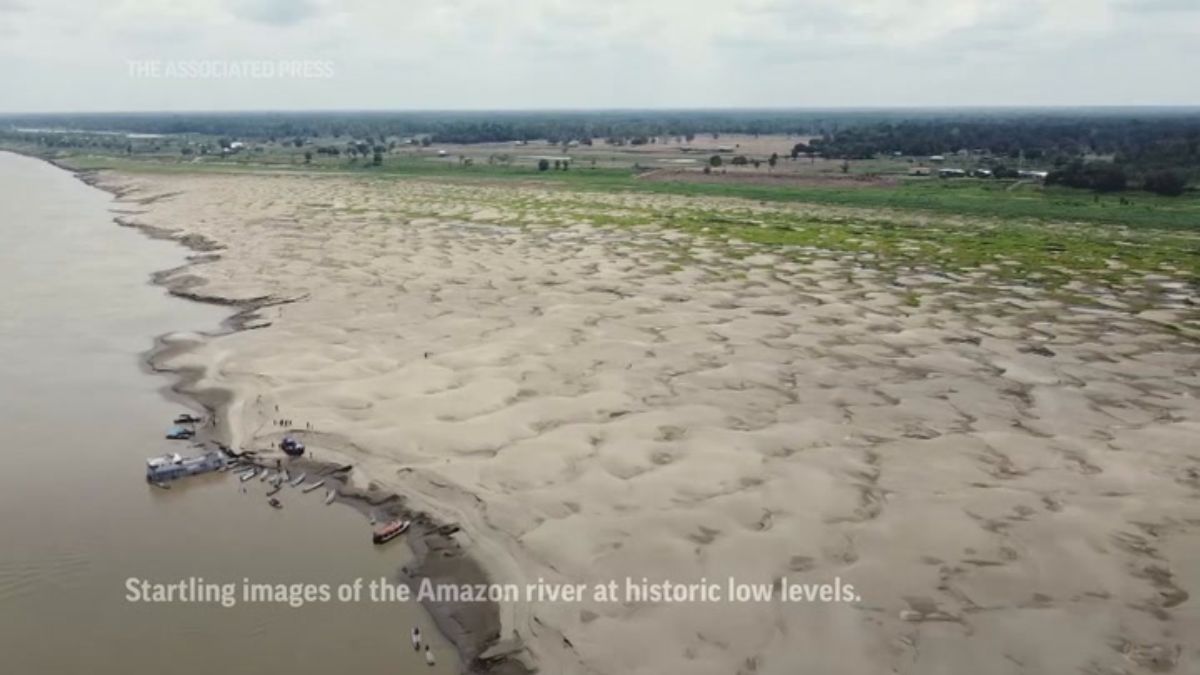The biggest drought in 121 years has occurred in the Amazon River.
Who has finally caught sight of the Amazon River, which is counted among the largest rivers in the world? Currently, the Amazon River is facing its biggest drought in 121 years. The water of this river has started boiling like lava and ash. Its temperature has reached 2 degrees more than the human body temperature. In such a situation, millions of aquatic animals have died. 150 dolphins were also among those who died. Due to severe drought, the lives of millions of people and animals in South African countries are in danger. This sudden drought in the Amazon River is a big challenge for scientists around the world. Is this a sign of some big danger for the world?
The Amazon River is currently experiencing unprecedented drought and this situation is projected to continue in the region until at least mid-2024. The river level in the city of Manaus is the lowest it has been in 121 years of records. Water levels dropped across a wide area of the Amazon river bed and more than 150 dolphins died in a lake where water temperatures reached 39 degrees Celsius (two degrees Celsius above human body temperature). Human settlements along the banks of the Amazon’s tributary rivers have become isolated, deprived of their livelihoods and lacking in basic amenities. This year, three types of drought are being faced simultaneously, due to which almost the entire Amazon region has been affected. Drought is predicted for almost the entire region from November 2023 to January 2024.
Increased risk of forest fire due to severe drought
Due to this terrible drought in the Amazon River, the risk of forest fire has also increased. Some projected rain in Peru could help raise Amazon River levels, but the broader region remains vulnerable to drought and wildfires. Eastern El Nino Eastern El Nino conditions are caused by warm waters in the eastern part of the equatorial Pacific Ocean, similar to what happened during the “Godzilla” El Nino of 2015, and the waters there are even warmer than in 2015. Is. Winds reaching speeds of up to 250 km per hour during Hurricane Otis that devastated Acapulco are testament to the havoc of heat in the eastern Pacific. In addition to drought in the northern Amazon, the impact of eastern El Niño extends to the southern part of the region, as evidenced by the 2015–2016 wildfires in Brazil’s Acre state and now by record low water levels. .
More than 2 lakh deaths occurred due to the drought that occurred 41 years ago.
Central El Niño Warm water in the eastern Pacific now extends into the central part of the ocean, where it intensifies central El Niño as it did in 1982 and 1997. El Nino causes severe drought in the northern Amazon, with Roraima province on Brazil’s border with Venezuela known for wildfires. In addition to the loss of trees in the Amazon due to the 1982 El Niño, more than 200,000 people died due to drought in Ethiopia and neighboring African countries. A 1995 report by the Intergovernmental Panel on Climate Change (IPCC) indicated that there had been some change in the global climate system, leading to an increase in the occurrence of El Niño conditions since 1975.
There is a possibility of drought in the river due to global warming
The 2007 IPCC report determined that “El Nino-like conditions” will occur more frequently due to global warming. This completely changes the political and moral context of these events because global warming is increasing due to human activities, and every country and even every individual can be held responsible for it. The probability of water temperatures in the central Pacific returning to “normal” temperatures is projected to be essentially zero by January–March 2024 and not reach 50 percent until May–July 2024. A third type of drought in the Amazon region is from the “Atlantic Dipole”, where water in the tropical North Atlantic Ocean becomes warmer, while water in the South Atlantic remains cooler. The ‘Atlantic Dipole’ causes drought in the southwestern part of the Amazon, as happened in 2005 and 2010. The current ‘Atlantic Dipole’ is projected to last until at least June 2024. (The Conversation)
Read also
Latest World News
